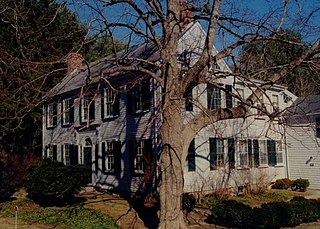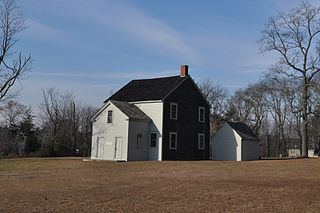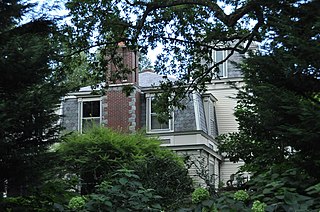
The Old South Meeting House is a historic Congregational church building located at the corner of Milk and Washington Streets in the Downtown Crossing area of Boston, Massachusetts, built in 1729. It gained fame as the organizing point for the Boston Tea Party on December 16, 1773. Five thousand or more colonists gathered at the Meeting House, the largest building in Boston at the time.

The American Antiquarian Society (AAS), located in Worcester, Massachusetts, is both a learned society and a national research library of pre-twentieth-century American history and culture. Founded in 1812, it is the oldest historical society in the United States with a national focus. Its main building, known as Antiquarian Hall, is a U.S. National Historic Landmark in recognition of this legacy. The mission of the AAS is to collect, preserve and make available for study all printed records of what is now known as the United States of America. This includes materials from the first European settlement through the year 1876.

The National Monument to the Forefathers, formerly known as the Pilgrim Monument, commemorates the Mayflower Pilgrims. Dedicated on August 1, 1889, it honors their ideals as later generally embraced by the United States. It is thought to be the world's largest solid granite monument.

Charles Howland Hammatt Billings (1818–1874) was an artist and architect from Boston, Massachusetts.

The Plymouth Antiquarian Society is a historical organization in Plymouth, Massachusetts. The Society, founded in 1919, owns and maintains the Harlow Old Fort House, the Spooner House, the Hedge House, and an ancient Native American site, Sacrifice Rock.

The Bartlett–Russell–Hedge House is a historic house in Plymouth, Massachusetts. Built in 1803, it is a fine local example of Federal architecture. It was listed on the National Register of Historic Places on April 30, 1976. It is presently part of a larger building that houses financial services businesses.

The Harlow Old Fort House is a First Period historic house at 119 Sandwich Street in Plymouth, Massachusetts.

The Jabez Howland House is a historic house at 33 Sandwich Street in Plymouth, Massachusetts.

The Old County Courthouse is an historic court house on Leyden Street and Market Street in the Town Square of Plymouth, Massachusetts. Built in 1749, the two-story wood-frame building is believed to be the oldest wooden courthouse in the United States; it stands on the site of the first courthouse built by Plymouth Colony settlers, and may incorporate elements of a 1670 building. The site was originally the site of Edward Winslow's first house in Plymouth.

The Sgt. Harlow William Family Homestead is a historic house at 8 Winter Street in Plymouth, Massachusetts. The oldest portion of this 1+1⁄2-story gambrel-roofed Cape house is believed to have been built by Sergeant William Harlow, before he built the nearby Old Harlow Fort House, and is believed to be one of Plymouth's oldest surviving buildings. It is unclear from the architectural evidence whether the original structure was a single cell or full width ; the asymmetry of the front facade suggests it was built in stages. The house has a large addition, which was added to the rear in the 19th century.

The Plymouth Village Historic District is a historic district encompassing part of the area of earliest settlement of the Plymouth Colony in Plymouth, Massachusetts. It includes properties in an area roughly bounded on the west by North Street, on the north by Water Street on the east by Town Brook, and on the south by Court Street and Main Street. The area includes Leyden Street and streets that were laid out as early as 1633, and nearby are some of Plymouth's oldest surviving houses. The site is near Plymouth Rock where the Pilgrims landed in 1620 and the Pilgrim Hall Museum containing many of their surviving artifacts.

The Capt. Gershom Bradford House is an historic house in Duxbury, Massachusetts. The two-story wood-frame house was built in 1807 by Captain Gershom Bradford. The main block has a side-gable roof, and is five bays wide and two deep. A two-story ell attached to the right rear connects the house to another addition, a replacement for a barn torn down c. 1900. The house is now owned and operated by the Duxbury Rural and Historical Society as a historic house museum, and has been decorated with original Bradford family furnishings to appear as it did during the 1840s.

The Pembroke Friends Meetinghouse is a historic Quaker church at Washington Street and Schoosett Street in Pembroke, Plymouth County, Massachusetts.

Hillside is a historic house located at 230 Summer Street in Plymouth, Massachusetts.

The Capt. Nathaniel Parker Red House is a historic house at 77–83 Ash Street in Reading, Massachusetts. It is a 2+1⁄2-story vernacular Georgian house, five bays wide, with entrances on its north and south facades. The southern entry is slightly more elegant, with flanking pilasters and a transom window. The house was built sometime before 1755, and was already a well-known landmark because it was painted, and served as a tavern on the coach road. The Tavern served as a meeting place for many revolutionaries and minute men, notably Marquis de Lafayette, and Alexander Hamilton. The house remained in the hands of militia captain Nathaniel Parker and his descendants into the late 19th century. The construction of the Andover Turnpike in 1806–07, bypassing its location, prompted a decline in the tavern's business.

The Horatio Tower House is a historic house at 71 Pleasant Street in Worcester, Massachusetts. It is one of the few relatively intact surviving instances of Italianate styling on the west side of the city. This two story frame house was built for Horatio Tower, a local builder whose work included the American Antiquarian Society hall and Mechanics Hall. Although the building has some Greek Revival features, its significant Italianate features include the deep cornice with brackets, and a front entry porch supported by Corinthian columns and a similarly styled roof.

The House at 170 Otis Street in Newton, Massachusetts is a rare local work of the nationally known Boston architect Hammatt Billings. The two story Second Empire house was built in 1870–71 for Charles Ellis and Emma Claflin Ellis, the daughter of William Claflin, then Governor of Massachusetts, whose own home was in Newtonville. The house's most prominent feature is its mansard-roofed 2+1⁄2-story tower, topped with iron cresting.

Hartwell and Richardson was a Boston, Massachusetts architectural firm established in 1881, by Henry Walker Hartwell (1833–1919) and William Cummings Richardson (1854–1935). The firm contributed significantly to the current building stock and architecture of the greater Boston area. Many of its buildings are listed on the National Register of Historic Places.

Edward Hammatt was an architect in the United States. He designed several notable buildings that are listed on the National Register of Historic Places.

Joseph Everett Chandler is considered a major proponent of the Colonial Revival architecture.























